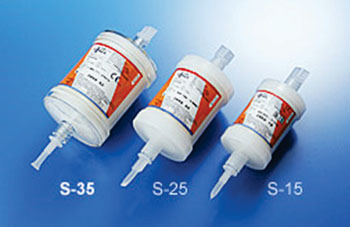Apheresis Column Treats Dialysis-Related Amyloidosis
By HospiMedica International staff writers
Posted on 19 Mar 2015
A new device treats dialysis-related amyloidosis (DRA), a chronic, progressive condition caused by the buildup in the body of a protein called beta 2-microglobulin (B2M).Posted on 19 Mar 2015
The Lixelle Beta 2-microglobulin Apheresis Column removes B2M molecules with the aid of porous cellulose beads specifically designed to bind to B2M as the patient’s blood passes over them. The filtration device is used prior to and in conjunction with hemodialysis. The device can help patients who have developed symptoms related to DRA, and may be especially useful for those patients who may not have access to extended dialysis therapies or who may not be eligible for kidney transplant.

Image: The Lixelle apheresis columns are available in three sizes (Photo courtesy of Kaneka).
The most common adverse events associated with use are temporary hypotension and a decrease in hematocrit, both of which are common adverse events for all patients undergoing dialysis or a similar extracorporeal therapy. The Lixelle Beta 2-microglobulin Apheresis Column is a product of Kaneka (Osaka, Japan), and has been approved by the US Food and Drug Administration (FDA) under the Humanitarian Device Exemption (HDE) pathway.
“While DRA affects only a small population of patients on dialysis, there are not many treatment options for these patients, and some options may not be available to patients in all areas,” said William Maisel, MD, MPH, chief scientist and acting director of the office of device evaluation in the FDA’s Center for Devices and Radiological Health (CDRH). “The Lixelle Beta 2-microglobulin Apheresis Column may provide this patient population with an option for relieving some of the debilitating symptoms of DRA.”
DRA is a complication of kidney failure, especially in people who have been on hemodialysis for more than five years. The buildup of B2M in the blood leads to deposits of the protein form in bones, joints, and tendons, resulting in painful and stiff joints, bone cysts that can lead to bone fractures, and torn tendons and ligaments. B2M deposits can also affect the digestive tract and internal organs such as the heart and lungs.
Related Links:
Kaneka














